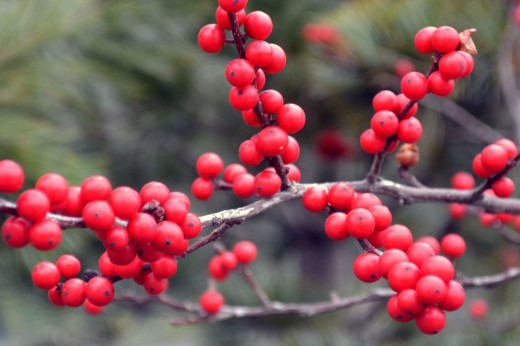Just as winter dormancy sets in outdoors, tropical fruits are in season in the Steinhardt Conservatory. Many plants grown as fruit crops in the tropics of Central and South America, Asia, and Africa produce quite well in the Tropical Pavilion. Late fall and winter are peak fruiting time. Look for familiar fruits like papaya and guava, which are ripening on the trees right now. You’ll also see more unusual specimens like petite orangeberries and big, bulbous jackfruit. Keep an eye out for them all!
Papaya (Carica papaya)
Family: Caricaceae
Papaya, or papaw, is native to Central America and northern South America and was first planted in Mexico several centuries ago. Today, it is grown throughout the Caribbean (and in Florida), Asia, and Africa. It’s the fourth most common tropical fruit grown worldwide, behind bananas, oranges, and mangoes, with India and Brazil the two main producers. When ripe, papaya’s skin and flesh are yellow to orange, and its center is filled with black seeds. The ripe fruits are eaten raw or can be candied or preserved. Unripe green fruits are used in salads, curries, and stews in Asian cuisines. In some cultures, the leaves are used to make tea believed to control malaria.
Orangeberry (Glycosmis pentaphylla)
Family: Rutaceae
Also called gin berry or Jamaica mandarin-orange, this obscure member of the citrus family is native to tropical Asia and Australia. Its fragrant white flowers are followed by these small, pinkish, round fruits, each containing one seed. Juicy and sweet, the fruits are eaten raw or used to make jam and jelly.
Black Pepper (Piper nigrum)
Family: Piperaceae
When you think of tropical fruit, black pepper probably doesn't come to mind, but this spice does in fact come from the fruit of a flowering vine native to Southeast Asia. Vietnam is the largest producer. The tiny fruits are harvested when green and then dried, at which point they are called peppercorns, the world’s most traded spice. Pepper has been widely used in cooking for centuries, but at one point it had at least one other use. Peppercorns were inserted in the nostrils of Ramses II as part of his mummification ritual in 1213 B.C.
Guava (Psidium guajava)
Family: Myrtaceae
Guava, a member of the myrtle family, is native to Mexico, Central America, and northern South America and was introduced to Florida in the 19th century. Fruits are greenish yellow to pinkish and have a lemon-rind fragrance. The ripe flesh is pale yellow to pink, with multiple seeds, and can be eaten raw, made into paste or jelly, or boiled and strained for juice or syrup. In Hawaii, the wood is used to smoke meat. Guava is one of the few tropical fruits that can be successfully grown in a pot indoors.
Loquat (Eriobotrya japonica)
Family: Rosaceae
Also known as Japanese or Chinese plum, loquat is a Chinese member of the rose family. It was introduced to Japan over 1,000 years ago, and Japan is now the top producer of loquat. The flowers, which appear in early winter, are white and and have a very sweet, fruity fragrance. The small round or oval fruits are yellow to light orange when ripe, with very juicy and sweet to tangy flesh and large seeds. Loquats are eaten out of hand and also used to make jams, jellies, and preserves.
Jackfruit (Artocarpus heterophyllus)
Family: Moraceae
Jackfruit is in the same family as mulberries and figs, but you wouldn't think that from its fruit size. It is the largest tree fruit in the world—mature specimens can weigh as much as 80 pounds! The tree is native to Southeast Asia, and archaeologists have found evidence that jackfruit was grown in India perhaps as far back as 6,000 years ago. The fruit turns dark brown when fully ripe and has a distinct, pungent aroma and tastes like a combination of apple, pineapple, banana, and mango. The seeds are also edible and can be boiled or roasted. It is the national fruit of Bangladesh, but Thailand and Vietnam are its major producers.



